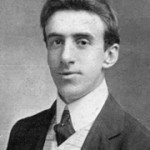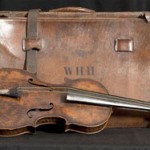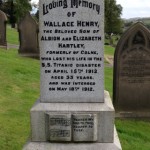Many famous legends and stories of bravery have risen from the sinking of Titanic, but some have stood the test of time because they capture the imaginations of those who read about them. From fearless Molly Brown to wireless operator Harold Bride, who relayed the ship’s S.O.S. message until he could do nothing else but give his life for the passengers, the sinking turned a few everyday people into heroes. However, there are few tales as heartbreaking and memorable as that of Wallace Hartley, the ship’s violinist, and how his final moments of bravery gave the ship’s passengers comfort as they fought for survival or faced certain death.
1. Talented From a Young Age
 Wallace H. Hartley was born in Lancashire, England, in June of 1878. His father was the choirmaster and superintendent at the Methodist church where Hartley’s family went to worship. From a young age, Hartley showed musical ability, singing in the church choir and learning to play the violin from a friend of the family who attended the same church. When his studies were through, he went to work for Craven & Union Bank, but he never strayed far from his love of music. He soon left that job to join the Huddersfield Philharmonic Orchestra. At the age of 25, he signed on with the municipal orchestra in Bridlington, but his travels would soon send him out to sea.
Wallace H. Hartley was born in Lancashire, England, in June of 1878. His father was the choirmaster and superintendent at the Methodist church where Hartley’s family went to worship. From a young age, Hartley showed musical ability, singing in the church choir and learning to play the violin from a friend of the family who attended the same church. When his studies were through, he went to work for Craven & Union Bank, but he never strayed far from his love of music. He soon left that job to join the Huddersfield Philharmonic Orchestra. At the age of 25, he signed on with the municipal orchestra in Bridlington, but his travels would soon send him out to sea.
2. A Sea-Going Musician
Soon after turning thirty, Hartley signed on with Cunard, an English-based cruise line that was often in need of musicians for their ships. The bands would entertain the passengers, play at Sunday services, and provide mealtime music for first-class passengers. He worked aboard several different ships, including the ill-fated RMS Lusitania, which was felled by a German torpedo in 1915. Cunard eventually transferred Hartley’s employment to C.W. & F.N. Black, a music agency that supplied musicians to cruise ships, and he was given second-class accommodations by the agency while at sea. Hartley would work on at least three different ships before he received his newest assignment: the band leader aboard the White Star Line’s newest and most crowned jewel: the RMS Titanic.
3. Life Aboard Titanic
 Once he took the job aboard Titanic, Hartley found himself as the leader of the ship’s eight-piece band. Titanic boasted the largest band to date, and the octet usually split into two groups to entertain the passengers. The band consisted of three violinists (including Hartley), a pianist, three cellists and a bassist. Hartley and four of the other band members were responsible for playing at teatime, on Sundays during worship and after supper. As it was on other ocean liners, it was mostly first-class passengers that enjoyed the band’s music.
Once he took the job aboard Titanic, Hartley found himself as the leader of the ship’s eight-piece band. Titanic boasted the largest band to date, and the octet usually split into two groups to entertain the passengers. The band consisted of three violinists (including Hartley), a pianist, three cellists and a bassist. Hartley and four of the other band members were responsible for playing at teatime, on Sundays during worship and after supper. As it was on other ocean liners, it was mostly first-class passengers that enjoyed the band’s music.
4. “Gentlemen, I Bid You Farewell!”
After Titanic struck an iceberg on the evening of April 14th, 1912, Hartley and his fellow band members brought their instruments up on deck to play music in hopes that it would calm the passengers as they were loaded into the lifeboats. It’s possible that Hartley and his fellow musicians did not recognize the serious peril the ship was in, or at least not at first. However, as panic increased and the ship began to sink, Hartley urged the band to keep playing. Near the end, the musicians must have realized their fate, Hartley included, and might have played as long as they did to comfort themselves as well as the passengers who no longer had the chance to get into a lifeboat. The band played “Nearer my God to Thee” and possibly “Autumn” before the bow became submersed in the icy water. Someone in a nearby lifeboat heard Hartley cry, “Gentlemen, I bid you farewell!” as the band members were dragged under. None survived the sinking.
5. A Legacy of Bravery
Wallace Hartley’s body was recovered almost two weeks after the sinking, and his violin, a gift from his beloved fiancé, was still strapped to his body. The instrument was eventually returned to the grieving woman, and then passed on to a family who kept it for well over 70 years until selling it at auction in 2013, where it fetched a staggering $1.6 million. It occasionally tours in Titanic exhibits to remind people of Hartley’s and the other musicians’ nobility and bravery in the face of death. Hartley’s remains now lie in Colne, Lancashire, very close to his boyhood home, under a monument that features a violin and the sheet music for “Nearer My God to Thee”.
Hartley’s legacy is likely to live on through generations of Titanic enthusiasts, many of whom view him as a true hero. No matter his intentions during those final moments on the ship, one undeniable fact remains: this soft-spoken violinist gave comfort to those aboard who were about to join him on the journey to the hereafter.


